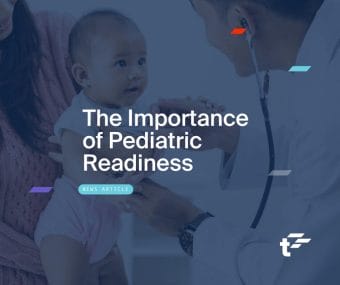
The Importance of Pediatric Readiness in Emergency Departments
Most sick and injured children in Canada are first seen in general emergency rooms and not specialized children’s hospitals. Oftentimes, the medical staff who are faced with children in emergency situations, are more familiar with treating adults and seniors than they are with child patients. For this reason, it is important that healthcare institutions put a concerted effort into pediatric readiness.
Pediatric readiness refers to the ability of an emergency department (ED) to provide the top standard of care to children. Having high pediatric readiness can save children’s lives. A recent U.S. study published in JAMA Pediatrics shows that improving ED pediatric readiness could prevent 1 in 4 deaths among critically ill or injured children.
A statement from Dr. Leah Crockett, Banting Postdoctoral Fellow in the Department of Pediatrics and Child Health at the University of Manitoba, and Dr. Alex Aregbesola, Assistant Professor, Department of Pediatrics & Child Health, University of Manitoba, illustrates the state of pediatric readiness in Canada.
“Evidence from a Canadian review suggests that If the general emergency readiness scores are high, a very ill child’s risk of death is cut down by 50% with a shorter length of stay in the hospital,” Dr. Crockett and Dr. Aregbesola wrote in an email.
According to Dr. Crockett and Dr. Aregbesola, the results in Canada are comparable to US findings, and suggest that improvements are needed. They also highlighted that Manitoba is leading the way in improving pediatric readiness.
“Provincial assessments of pediatric readiness have been conducted in Canada, starting with Alberta (median score: 46.6/100) and Manitoba in 2019/20 (median score: 52.3/100), with other provinces following suit. These results are comparable to US findings and indicate a clear room for improvement, particularly in pediatric care coordination, quality improvement, and staffing and training. Manitoba is currently leading the first clinical trial to test targeted intervention strategies to strengthen pediatric readiness in general emergency departments.”
What Is Pediatric Readiness?
Pediatric readiness refers to an emergency department’s ability to effectively care for children. This includes having the right equipment, policies, trained staff, and clinical resources specific to pediatric patients. Unlike adults, children have unique medical needs that require specialized attention, especially in emergency situations.
The Life-Saving Impact of Pediatric Readiness
The JAMA Pediatrics study, cited above, analyzed nearly 800,000 pediatric cases across 983 emergency departments in the United States. It found that facilities in the highest quartile of pediatric readiness had significantly lower mortality rates. If all EDs operated at that level, more than 1,400 pediatric deaths could have been prevented during the study period.
This research underscores the tangible and urgent impact of pediatric readiness on child health outcomes. It also highlights the need for nationwide systems and supports that can elevate readiness across every type of emergency care setting.
In the Canadian context, the statement by Dr. Crockett and Dr. Aregbesola reiterated the need for a nation-wide system as efforts to improve pediatric readiness are growing provincially.
“While efforts remain provincial, momentum is building toward a coordinated national approach. TREKK’s trusted, evidence-based resources – developed here in Canada – have been critical in filling this gap,” the statement said.
How TREKK Supports Pediatric Readiness Across Canada
Translating Emergency Knowledge for Kids (TREKK) is a national knowledge mobilization network created to close critical gaps in pediatric emergency care. TREKK works directly with general emergency departments, rural and remote nursing stations, and families to co-create and share evidence-based resources that improve pediatric readiness.
Key Ways TREKK Supports Peds Readiness:
- Co-develops Clinical Tools: TREKK partners with clinicians, researchers, and families to create trusted, up-to-date tools on over 40 pediatric topics such as asthma, anaphylaxis, and fractures.
- Supports Non-Children’s Hospitals: Since most children are treated in general EDs, TREKK ensures that front-line providers have access to child-specific information and tools, even in resource-limited environments.
- Delivers Accessible Education: TREKK’s resources are tailored for both healthcare professionals and families, helping everyone involved in a child’s care feel confident and prepared.
- Mobilizes Knowledge Nationwide: Through a network of over 230 collaborators and 120+ committee members and content advisors, TREKK provides information and resources to help healthcare providers deliver evidence-based care to child patients.
Organizations like TREKK play a vital role in making this possible by equipping healthcare providers and families with the knowledge and tools they need to act quickly and effectively when a child’s life is at stake.
See our resources for parents and families, and healthcare providers.
Sign up to our newsletter for the latest updates on TREKK resources.

